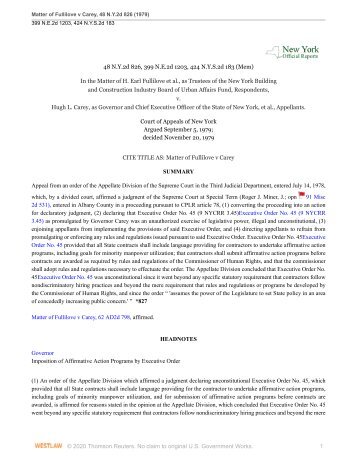The Percy Program
It is a fight to level the playing field to be able to compete for jobs and careers on the basis of skills and make available apprentice training to all. In 1973 Al Percy launched a class action lawsuit to give workers like him a chance to better their lot in life. It would also ensure the availability of skilled workers to build the infrastructure of the future.
384_F.Supp 800, 807
- Text
- Class action
- Reparations
- Complaint
- Determination
- Defendants
- Affirmative
- Products
- Requirements
- Household
- Insecticides
- Employment
- Plaintiffs
384_F.Supp 800,
800 384 FEDERAL SUPPLEMENT owners and apartment dwellers, whereas lawn and garden insecticides are limited to homeowners with gardens and lawns. 5. Household insecticides and garden insecticides utilize different channels of distribution. Household products are sold predominantly in grocery and drug stores, while lawn and gardJn products are sold in garden shops and i garden departments of department stor~s. 6. The competitors which dominate the sales of household insecticides are different from those which iead in the area of lawn and garden chemicals. Science's arguments ignore the competitive realities of the marketplace. Household insecticides share the same chemical components and manufacturing facilities with insecticides labeled and intended for outdoor use. Once a manufacturer enters the lawn and garden chemical field, it can easily expand its product line to include househpld insecticides. This, in fact, has been the case. For example, S. C. Johnson, one of the leading manufacturers of aerosol household insecticides, also markets lawn and garden products and is presently testmarketing a lawn fertilizer. · Similarly, every manufacturer of lawn and garden chemicals also markets at least a few household insecticides. · Significantly, both Science and Chevron manufacture and market products falling into every category including household insecticides. Although some producers of household insecti'cides tend I to concentrate their sales in grocery and drug stores, in general, most distributors and retailers of lawn and garden chemicals also handle household insecticides. Moreover, Science has been unable to point to a single manufacturer which makes any distinction in its organization or personnel based upon products sold for use inside and outside the home. Science's attempts to distinguish household insecticides from outdoor insecticides based on locus of use must fail. Of the eight products listed under Chevron's "Household Program," six are specifically labeled suitable for outdoor use. Science's argument that household insecticides are lower in toxicity than products intended for outdoor use is equally specious. Most household insecticides are packaged in aerosol form and therefore in final diluted form. By contrast, many outdoor insecticides are packaged in concentrated form and must be diluted with water before they can safely be used. Once diluted, the toxicity of these products is no stronger and often weaker than the toxicity of household insecticides. [5] Thus, it can reasonably be concluded that household insecticides do not represent a relevant market or submarket. IV. Conclusion [6] For the foregoing reasons, the court is of the opinion that, unless significant new evidence is introduced at trial, the relevant product market for the purposes of Science's antitrust claims must be the market for all products which affect plant or insect life in and around the home. w 0 i K',-EY-HU-H-BE-R S-YS-TEH""' T Albert E. PERCY et al., Plaintiffs, v. Peter J. BRENNAN, Secretary of Labor, et al., Defendants. No. 78 Civ. 4279. United States. District Court, S. D. New York. Nov. 8, 1974. Action on behalf of minority person seeking training and employment in New York construction industry challenging the affirmative action plan governing federal and state-assisted construction projects. The District Court, Lasker, J., held that the plaintiffs were not required to exhaust federal, state, or
- Page 2 and 3: PERCY v. BRENNAN 801 Cite as 384 F.
- Page 4 and 5: PERCY v. BRENNAN Cite as 384 F.Supp
- Page 6 and 7: PERCY v. BRENNAN Cite as 384 F.Supp
- Page 8 and 9: PERCYv. BRENNAN 807 Cite as 384 F.S
- Page 10 and 11: PERCYv. BRENNAN Cite as 384 F.Supp.
- Page 12 and 13: approved the maintenance of an acti
- Page 14 and 15: PERCY v. BRENNAN 813 Cite as 384 F.
Inappropriate
Loading...
Mail this publication
Loading...
Embed
Loading...












